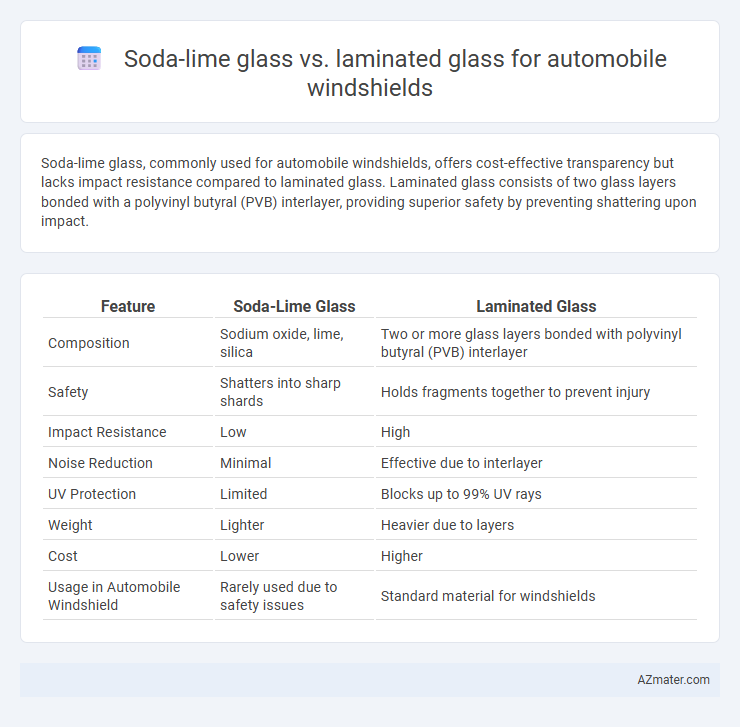Soda-lime glass, commonly used for automobile windshields, offers cost-effective transparency but lacks impact resistance compared to laminated glass. Laminated glass consists of two glass layers bonded with a polyvinyl butyral (PVB) interlayer, providing superior safety by preventing shattering upon impact.
Table of Comparison
| Feature | Soda-Lime Glass | Laminated Glass |
|---|---|---|
| Composition | Sodium oxide, lime, silica | Two or more glass layers bonded with polyvinyl butyral (PVB) interlayer |
| Safety | Shatters into sharp shards | Holds fragments together to prevent injury |
| Impact Resistance | Low | High |
| Noise Reduction | Minimal | Effective due to interlayer |
| UV Protection | Limited | Blocks up to 99% UV rays |
| Weight | Lighter | Heavier due to layers |
| Cost | Lower | Higher |
| Usage in Automobile Windshield | Rarely used due to safety issues | Standard material for windshields |
Introduction to Automotive Windshield Glass
Automotive windshield glass primarily utilizes soda-lime glass and laminated glass, with laminated glass being the industry standard due to its enhanced safety features. Soda-lime glass, composed mainly of silica, soda, and lime, lacks the interlayer found in laminated glass, making it prone to shattering upon impact. Laminated glass incorporates a polyvinyl butyral (PVB) interlayer that holds shards together, significantly improving impact resistance and protecting occupants during collisions.
What is Soda-Lime Glass?
Soda-lime glass is the most common type of glass used in automobile windshields due to its affordability and ease of manufacturing. It consists primarily of silica (SiO2), sodium oxide (Na2O), and calcium oxide (CaO), providing a balance of strength and clarity. When laminated with polyvinyl butyral (PVB), soda-lime glass enhances impact resistance and safety by holding shards together upon breakage.
What is Laminated Glass?
Laminated glass consists of two or more layers of glass bonded together with an interlayer, typically made of polyvinyl butyral (PVB), which enhances safety by preventing the glass from shattering upon impact. Unlike soda-lime glass, which is a single, brittle layer, laminated glass provides superior strength, improved impact resistance, and better sound insulation, making it the preferred choice for automobile windshields. Its ability to hold together during accidents reduces the risk of injury from flying glass shards, ensuring enhanced passenger protection.
Manufacturing Process Comparison
Soda-lime glass for automobile windshields is manufactured through the float glass process, where molten glass is floated on a bed of molten tin to achieve uniform thickness and smooth surfaces, then cut and tempered to enhance strength. Laminated glass involves bonding two or more layers of glass with a polyvinyl butyral (PVB) interlayer under heat and pressure, providing improved safety by preventing shattering upon impact. The laminated glass manufacturing process is more complex and time-consuming compared to soda-lime, incorporating additional lamination and curing stages to ensure high durability and impact resistance for automotive use.
Safety Performance: Soda-Lime vs Laminated Glass
Laminated glass outperforms soda-lime glass in safety performance for automobile windshields due to its multi-layer structure, which includes a polyvinyl butyral (PVB) interlayer that holds shards together upon impact. Soda-lime glass, being more brittle, shatters into sharp fragments, increasing the risk of injury during collisions. Regulatory standards like FMVSS 205 mandate laminated glass for windshields to enhance occupant protection and maintain structural integrity in crashes.
Durability and Impact Resistance
Laminated glass, composed of two layers of soda-lime glass bonded with an interlayer, offers superior impact resistance and durability compared to standard soda-lime glass, making it ideal for automobile windshields. The interlayer in laminated glass absorbs and distributes impact forces, preventing shattering and enhancing passenger safety during collisions. Soda-lime glass alone lacks this protective layer, resulting in lower impact resistance and higher vulnerability to breakage under stress.
Optical Clarity and Visibility
Soda-lime glass, commonly used in automobile windshields, offers decent optical clarity but can present minor distortions due to its inherent material properties. Laminated glass, consisting of two layers of glass bonded with an interlayer, provides superior optical clarity and enhanced visibility by reducing glare and minimizing distortions, crucial for driver safety. This construction also effectively maintains clarity even after impacts or cracks, ensuring consistent visibility compared to soda-lime glass.
Cost Analysis and Economic Factors
Soda-lime glass is the most cost-effective material for automobile windshields due to its low production costs and abundant raw materials, making it widely used in standard vehicles. Laminated glass, while more expensive upfront because of its multilayer construction involving PVB interlayers, offers superior safety and durability, potentially reducing long-term economic losses from accident-related repairs. Economically, laminated glass enhances vehicle value and insurance benefits, justifying the higher initial investment through improved safety compliance and reduced replacement frequency.
Environmental Impact and Recycling
Soda-lime glass, commonly used in automobile windshields, is highly recyclable due to its simple composition, allowing it to be melted and remanufactured with minimal environmental impact. Laminated glass, composed of multiple layers including polyvinyl butyral (PVB) interlayers, presents challenges in recycling because the plastic interlayer requires separation from the glass, often leading to increased waste or downcycling. The recycling infrastructure favors soda-lime glass, making laminated glass less efficient in circular material flow and contributing to higher environmental footprints in automotive glass disposal.
Which Glass is Best for Automobile Windshields?
Laminated glass is the best choice for automobile windshields due to its enhanced safety features, consisting of two layers of soda-lime glass bonded with an interlayer of polyvinyl butyral (PVB) that prevents shattering upon impact. Soda-lime glass alone lacks this interlayer, making it more prone to breakage and less effective in protecting passengers during collisions. The durability and impact resistance of laminated glass significantly improve windshield safety standards in vehicles.

Infographic: Soda-lime glass vs Laminated glass for Automobile windshield
 azmater.com
azmater.com